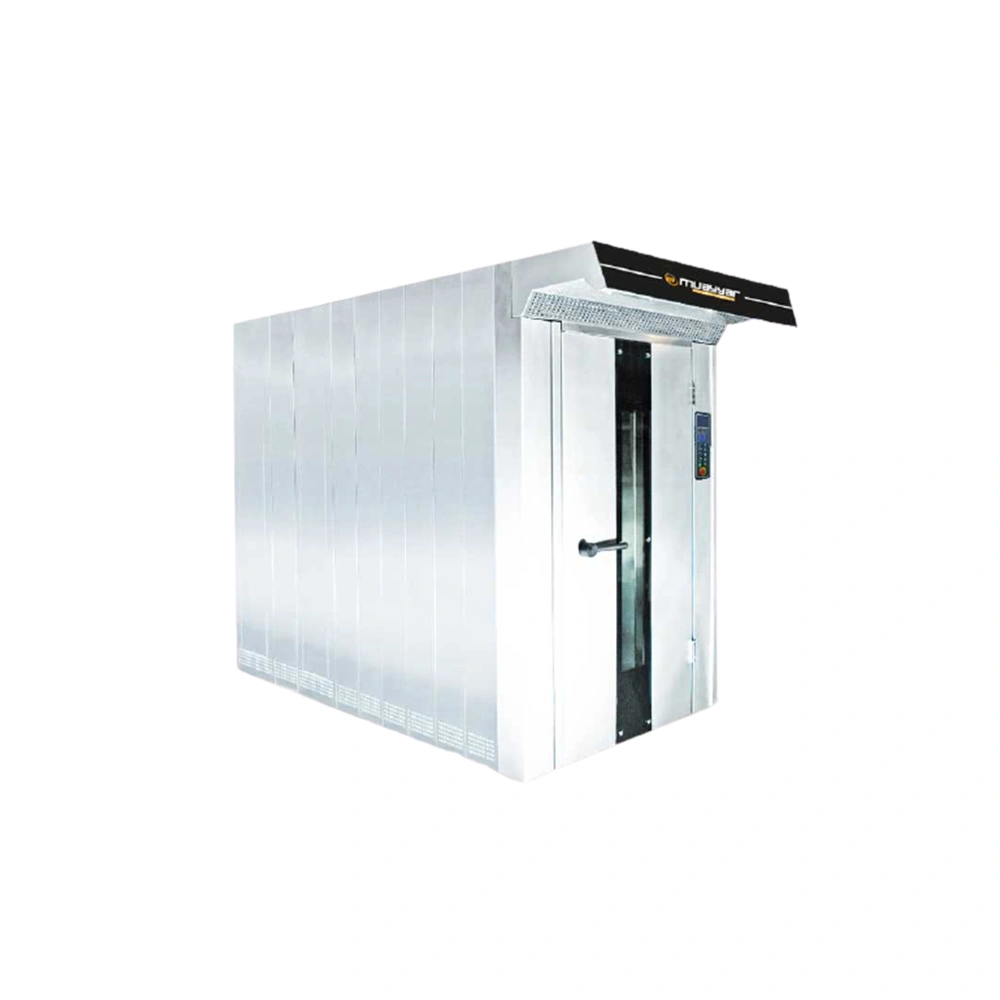Electric Rotary Rack Oven
Technicial Specifications
| Model | Unit | MDF 150 | MDF 200 | MDF 300 |
| Capacity* 8 h/dough |
kg | 1200 | 2150 | 2400 |
| Baking surface | m2 | 6,6-8,5 | 11,2-14,4 | 19.2 |
| Number of trays | adet | 14-18 | 14-18 | 32 |
| Tray size | mm | 600×800 | 750×1040-740×980 800×1000 |
600’800×2 800*1200 |
| Distance between trays | mm | 114-90 | 114-90 | 114-90 |
| Width(W) | mm | 1300 | 1600 | 1900 |
| Length (L) | mm | 2000 | 2350 | 2500 |
| Height (H) | mm | 2250 | 2250 | 2250 |
| Electrical power | Kw | 3,5 | 3.5 | 5.5 |
| Heating capacity | kcal / saat | 60000 | 70000 | 95000 |
| Gas coupling pressure | mbar | 50 | 50 | 50 |
| Source of energy | ||||
| Weight of oven | kg | 1450 | 1750 | 2450 |
| Control system | Manual, Digital and PLC | |||
| Consumption** | Diesel (lt/h) |
6,8 | 8 | 11 |
| Natural Gas (m3/h) |
7.9 | 9.2 | 12.5 | |
| LPG (lt/h) |
6 | 6.8 | 9 | |
Unique Features of Electric Rotary Rack Ovens
- Heating Mechanism: Electric rotary rack ovens utilize electric heating elements as their primary source of heat, providing consistent and precise temperature control throughout the baking process. This differs from other types of ovens, such as convection ovens or deck ovens, which may use different heating mechanisms like gas burners or radiant heat.
- Rotating Rack System: The rotating rack system in electric rotary rack ovens allows for efficient airflow and even heat distribution, ensuring uniform baking across all trays or racks. This rotating feature is unique to rotary rack ovens and contributes to their high baking capacity and consistency in product quality.
- Energy Efficiency: Electric rotary rack ovens are known for their energy efficiency, as they eliminate the need for gas fuel and combustion. Electric heating elements convert electricity directly into heat, resulting in efficient energy utilization during baking. This makes them a preferred choice for bakeries seeking to reduce their carbon footprint and energy costs.
- Steam Injection System: Many electric rotary rack ovens come equipped with steam injection systems, allowing for precise control over steam levels during the baking process. Steam helps improve crust development, promote oven spring, and enhance the texture of baked goods, contributing to better product quality and consistency.
- Temperature and Humidity Control: Advanced electric rotary rack ovens feature precise temperature and humidity control systems, allowing operators to adjust these parameters to optimize baking conditions for specific recipes. This level of control ensures consistent baking results and allows for customization based on the requirements of different baked goods.
- Versatility: Electric rotary rack ovens are versatile and can accommodate various types of baked goods, including bread, pastries, cakes, cookies, and more. Their high baking capacity and uniform baking capabilities make them suitable for bakeries with diverse product offerings and production needs.
Differences from Gas Rotary Rack Ovens
While electric and gas rotary rack ovens share many similarities in terms of their rotating rack systems and high baking capacities, there are some key differences:
- Heating Source: Gas rotary rack ovens are powered by gas burners, while electric rotary rack ovens utilize electric heating elements. This difference in heating source can impact factors such as energy efficiency, heat distribution, and baking performance.
- Energy Consumption: Electric rotary rack ovens tend to have lower energy consumption compared to gas ovens, as they eliminate the need for gas fuel and combustion. This can result in cost savings over time, especially in regions where electricity costs are lower than gas.
- Installation Requirements: Gas rotary rack ovens require access to a gas supply line for operation, while electric ovens only need access to electrical power. This difference in installation requirements may influence the choice of oven based on the available utilities and infrastructure.
- Temperature Control: Electric rotary rack ovens offer precise temperature control through electric heating elements, while gas ovens may require additional adjustments to maintain consistent baking temperatures.
- Maintenance and Safety: Electric rotary rack ovens may require less maintenance compared to gas ovens, as there are no gas burners or combustion-related components to inspect and maintain. Additionally, electric ovens eliminate the risk of gas leaks or combustion-related safety hazards.
Electric rotary rack ovens offer unique features and advantages that distinguish them from other types of ovens, including precise temperature control, energy efficiency, and versatile baking capabilities. Their rotating rack systems, electric heating elements, and advanced control systems make them ideal for commercial bakeries and food production facilities seeking efficient and consistent baking solutions.
In summary, electric rotary rack ovens provide a reliable and efficient baking solution for a wide range of baked goods, offering precise control, energy efficiency, and versatility in commercial bakery operations.


Reviews
There are no reviews yet.